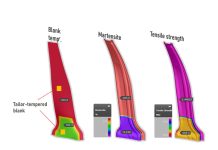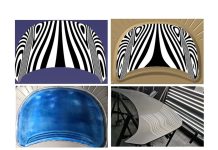The Formability of sheet metals
Previous posts Materials Matters, “the known unknowns” and “Material plasticity visualized” covered the general aspects, common terminology, and formulation of the plastic properties in sheet metal forming problems. Accurate definition of flow curves, kinematic hardening and yield locus helps us to simulate the plastic flow of sheet metals during forming operation. Computer simulation uses those definitions to predict at each location in the sheet how the metal will deform and how strong the material is at each point after the deformation. Reliable prediction of the strains and resultant stresses in sheet metal allows us to simulate the springback with high accuracy. However, computing plastic deformation is not enough alone to predict the formability of a stamped component.
In the context of metal forming, formability can be defined in general sense as:
Capability of a material to be formed without failure
Failure can show itself as necking, splits, or wrinkles. A widely used method for failure prediction in industrial applications was proposed by Keeler (1965) and Goodwin (1968), namely the forming limit curve (FLC). The method has found a broad application because it is empirical, intuitive, and easy to understand and apply.
The concept is very simple: take the sheet metal you wish to characterize, deform it until necking, record the maximum achievable strains before necking and use these values as to define deformation limits. Applying the limits to numerical simulation should predict if the deformation is safe or not.

Circle grid data collection for FLC determination

Marciniak test with optical strain measurement pattern applied
FLC determination
Experimental determination of these limits is performed by using different specimen geometries in order to obtain different deformation states. The specimens are usually stretched over spherical or cylindrical punches (Nakajima or Marciniak Tests). Traditionally, circle grid analysis was performed by technicians to samples artfully collected prior to the onset of failure, and then charted manually.
However, more recently optical strain measurement systems are utilized to capture the deformation history of the entire sheet surface. By this way the time point of localized necking and the corresponding strains can be identified with high accuracy. Obtained strain values from different specimen geometries are plotted in principal strain space.
A forming limit curve (FLC) is constructed by fitting a curve to the obtained coordinates (ema, emi) in strain-space. The FLC is specific for the grade of material tested, with same mechanical properties, at the same thickness. In time, if enough samples are taken, it is sometimes possible to apply a consistent curve shape for a range of materials and predict the forming limit of similar materials at different thicknesses. Such was the conclusion of Keeler-Goodwin et al with the publishing of their FLD0 (orFLC0), for mild steels. With the FLC0 formulation, given thickness and material n-value the location of a common shape FLC could be determined. However, for other materials a predictive shape and location of the FLC is not as widely accepted, requiring new empirical tests for each new material thickness and/or type.
Using FLCs
Later in the simulations the Forming Limit Curve defines the onset of necking. In post-processing of the finite element simulations, the strain state of each element is checked relative to the curve. If the strain state lies well below the curve, the elements are predicted to be safe. Points that lie below but are near the curve are considered to be marginally safe. A strain state over the line predicts a potential split. According to the position of the elements on the forming limit diagram other cases like thickening, excessive thinning or insufficient stretching can be defined.

By plotting the strains measured on a current panel against the FLC we can predict relative formability of that part or process
Strictly speaking, FLCs are valid for forming operations with linear strain paths. FLC determination is performed using specimen geometries and deformations with linear strain paths. If strain paths change, e.g. the part is stretched then compressed then stretched again, the standard FLC may not reliably predict failure. This is a major concern for engineering forming operations; it is possible that with appropriate knowledge an FLC can be modified to include non-linear strain path effects.
The concept of FLC does not have information about shear deformation or failure, thickness effects, or edge quality of the sheets. For the cases like, shear fracture of AHSS, bending over sharp radii and edge crack sensitivity of laser cut sheets alternative fracture criteria can be utilized. These criteria complement the information in FLCs with maximum available shear strains or edge strains.
Future trends:
Given the limitations of FLCs further academic research is ongoing and focuses currently on following points
- Time dependent evaluation of the FLD-test results in order to identify the onset of necking more accurately
- Strain path dependent FLCs including anisotropy effects
- Stress based FLCs
- Determination of temperature dependent FLCs for hot forming applications
- Continuum damage mechanics
- Fracture prediction based on crystal plasticity and surface texture
- Computation and prediction of FLCs based on constitutive equations.
See part one, two and three of this series.














Hello everybody,
Nice item, thank you for similar article. I have one question from evaluation of crack or splits from contour ets. How do you experience or recommendation from evaluation of plastic strain? Because FLC didn’t show there.
Ok, general recommendation from AutoForm: Lower Limits is about 0.03 but where is upper limits?
Of course upper value is dependent of material property but is there any proposition? For medium strength steel, high strength steel or aluminium?
Jakub,
Are you asking what recommendations we have regarding the recommended threshold (or safety margin) from FLC when determining process safety from splitting failure?
Or are you asking what we recommend as an upper limit of the output variable plastic strain?
Regarding FLC safety margin there is NO simple answer for safety margin that is globally accepted. Originally, the Keeler-Goodwin recommendation was an arbitrary 0.10 major strain (* 10% engineering strain) shift of the FLC lower. However, many find this concept to limiting to be used for materials of different strengths or original thickness. Some within the AutoForm community might also prefer to define a marginal zone which is proportionally 0.20% safer than the defined failure strains (if failure happens at 100% of FLC, then define a marginal zone which is proportionally 20% lower in strain space. At least this threshold allows for marginal zones which will not overly reduce the safe forming areas for material like HSS, AHSS, and Aluminium.
If you are asking about an upper threshold limit for result variable “PLASTIC STRAIN”. There is not definable safe limit for Plastic Strain, for was we know from FLC theory various combinations of major and minor strain which might in fact achieve varying maximums of “effective plastic strain”. Similar for Thickness strain (or thinning). The reason why FLC’s exist it that defining a single threshold for plastic strain to be safe of not was not possible.
In either case this brings up very good points for future blog posts:
– marginal FLC safety
– limits for commonly used result variables
– … more?
Thanks for the comment, let us know how else we might address your concerns.
Thank you for you answer Erik. I look forward to next article: marginal FLC safety and limits for commonly used results variables etc… Thanks
Great overview!
A few other points, with some actually being pertinent to the post:
A) Even if a part is shown to be FLD-safe, there can be the risk of durability issues. This is one reason that some companies will have the requirement that all areas are FLD-safe AND that no areas thin by more than 20%.
B) For grades that are not mild steel, you correctly note that empirical tests are needed to determine curve shape and placement as a function of material and thickness. Many of these grades do not have the characteristic shape of a “checkmark”, but instead either or both edges can curve up or down. If there are only 2 tests to the left of plane strain, this curvature of the FLC may not be fully captured. I have the same concern on the RH side of plane strain, except most engineered parts have a minor strain of at most +10% and most curves capture this range satisfactorily.
C) Using the optical strain measurement described involves putting down a layer of white paint then spraying on black dots in a random pattern. The sample is taken to fracture with the dot movement recorded, then the images are backed up to the point of perceived necking. But the fracture that stops the test is the fracture of the white paint. Do all metals paint the same way? Do all white paints have the same compliance? Do all users of this method spray on the same amount of white paint? Are all tests done with the paint dried the same amount? Next comes the method of backing up the images to determine necking. Different metals have different amounts of post-uniform elongation, so using the same number of images is not a good method. The bottom line is that while this method may achieve high precision, I do not know if I agree that it has high accuracy.
Danny Schaeffler
Engineering Quality Solutions, Inc. … http://www.EQSgroup.com
4M Partners, LLC … http://www.Learning4M.com
Thank you Danny for the thoughtful reading of the blog and your feedback. You raise many good points regarding FLCs. It is a very deep topic to which we have only thus far done a very cursory introduction.
[…] The bad news: There is no single definition of a worst case material. […]